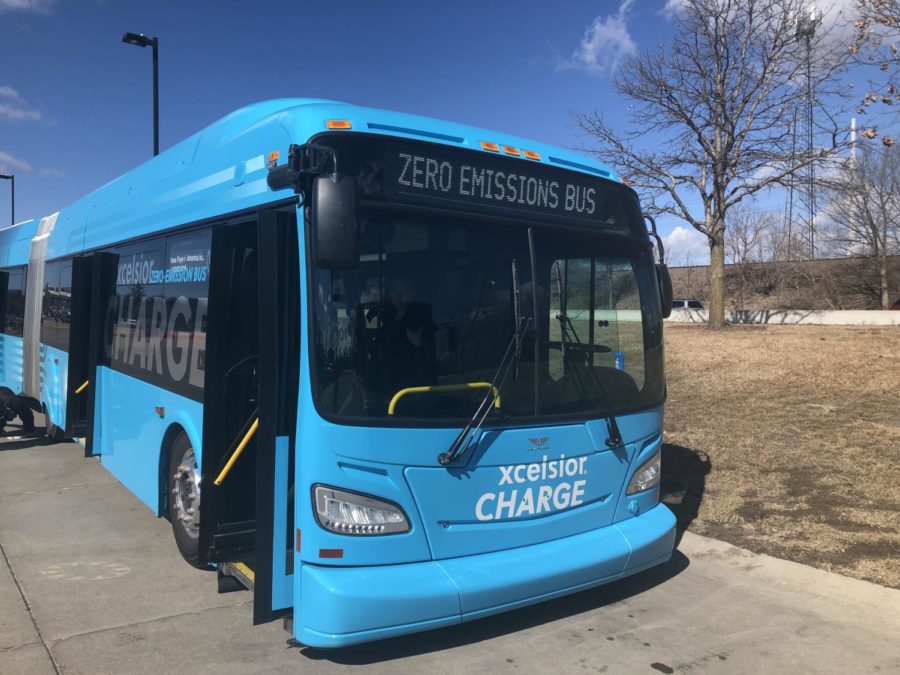CyRide demonstrates battery-electric bus after receiving grant
March 3, 2020
Throughout the late morning and early afternoon on Tuesday, some Iowa State students may have seen a blue bus driving around campus.
This blue bus was one of the “Xcelsior CHARGE” buses from New Flyer of America, one of the largest transit bus manufacturers in North America, with fabrication, manufacturing and service centers in the United States and Canada.
“New Flyer is one of the few companies that make fully electric buses and was excited to come out and give us a demo and that’s what today was,” said Kevin Gries, transit operations manager for CyRide. “I actually got to drive it on the Orange Route and if we were ever to get a fully electric [articulated] bus, that is where we would use it because that is where we have the most passengers.”
On Tuesday, Gries drove the blue New Flyer bus along the Orange Route multiple times, picking up passengers at stops like a regular bus.
“We took it out for a couple of trips and it was nice,” Gries said. “Very smooth, very quick, very quiet.”
Although many people were confused when the bus pulled up because it was blue, the passengers did get over this confusion after the CyRide personnel on board explained what was happening.
Keith Wilbur, transit technology coordinator/dispatcher for CyRide, told a passenger that if they did decide to get one of these buses they would have it painted with the normal CyRide colors to limit this type of confusion.
Gries said this was the first fully electric articulated bus that CyRide has demoed, but he said CyRide has tested a couple of fully electric 40-foot buses before this.
“We are actually on track to purchase a couple of [fully electric 40-foot buses] pretty soon,” Gries said.
CyRide is planning to purchase these buses through the help of a grant they recently received.
“We are looking to buy two buses to start with,” Gries said. “We got a grant, it helps us to try out new technologies like this because typically newer technologies are more expensive and grants help offset the cost.”
In May 2019 CyRide submitted a Low-No Emission National Grant Submission to the Federal Transit Administration in Washington, D.C., for battery-electric buses to move forward in implementing zero-emission buses into the fleet by spring 2022.
Overall, the grant requested funding for two battery-electric buses; equipment including a 480-volt transformer, dispensing station and chargers; facility modifications including wiring, conduit and connections from the transformer to dispensers/chargers; and project management and employee training on the new equipment.
The total project cost is $2,137,800, with a federal request of $1,660,180, which is 78 percent, according to a CyRide newsletter from May 24.
The grant was approved and fully funded at the request of $1,660,180.
Currently, CyRide has not decided which company to buy from for the two buses they are interested in purchasing, which means there may be more demo buses coming to Iowa State.
Gries said CyRide is looking into getting these battery-electric buses because they are fully electric and it will help reduce carbon emissions and therefore be better for the environment.
“This project is anticipated to eliminate 205 short tons of greenhouse gases, 46 lbs. of PM10, 24 lbs. of PM2 and 2.4 Terajoules of energy usage per year,” according to the CyRide newsletter.
The bus that was driven by Gries on Tuesday was the Xcelsior CHARGE, one of New Flyer of America’s fleet of battery-electric buses.
Xcelsior CHARGE buses use an electric motor powered by energy stored in rechargeable batteries. All onboard sub-systems and accessories are electrically driven.
“The air compressor and air conditioning compressors are electrically powered,” according to the New Flyer of America website. “[Direct current] power is converted to [alternating current] power and is supplied to each of these major systems separately. This allows each system to operate more reliably and efficiently, with minimum power consumption.”
The bus also has a converter to supply 24-volt direct current power for power steering, interior fans, lights, electric doors and other accessories.
Xcelsior CHARGE buses have a range of up to 225 miles on a single charge, according to the New Flyer of America website. New Flyer offers both plug-in charging and on-route charging solutions that meet industry standards and are interoperable with other electric vehicles.
Other facts about the Xcelsior CHARGE according to the the New Flyer of America website include:
-The Xcelsior CHARGE bus is available in 35-foot, 40-foot and 60-foot.
-The bus is industry-leading range capability from 160 kilowatt-hour (kWh) to 466 kWh of electricity.
-The bus is monitored by a battery management system for added protection, longevity and charging efficiency.
-The bus includes direct drive, which means no transmission is required, reducing cost, weight, maintenance and propulsion complexity
-The bus includes regenerative braking while decelerating to recharge the batteries, reducing energy consumption and extending range.
-People who buy the bus can save up to $400,000 in fuel costs over the 12-year life of the battery-electric bus.
-The bus has the lowest noise levels in the industry.
-People who buy the bus can have $125,000 in maintenance savings over the 12-year life of the bus with the absence of engine, transmission, intake and exhaust.

















